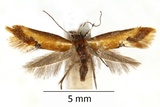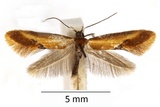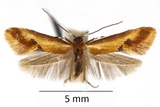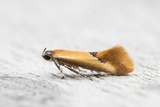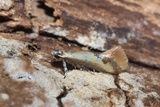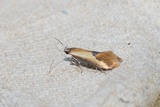Batia lunaris (Haworth, 1828) Species
Last modified: Dec. 8, 2025, 5:31 p.m.
A rather common species throughout Belgium, especially in the northern part of the country.
Details
- Classification
- Family: Oecophoridae > Subfamily: Oecophorinae > Genus: Batia > Species: Batia lunaris
- Vernacular names
- Kleine mosboorder (NL), Kleiner Ginsterrindenfalter (DE)
- Synonyms
- Batia metznerella (Treitschke, 1835)
- First mention in Belgium
- De Fré Ch. 1858. Catalogue des Microlépidoptères de la Belgique. — Annales de la Société entomologique belge 2: 45–162. On page 123 (as OE.[cophora] Metznerella. Tr.). view page
- Status
-
Native
Distribution
Egg
Yellowish grey, oval with flattened sides, surface wrinkled; diameter 0.125 mm.
Caterpillar
Whitish grey with two purplish brown transverse bands on each segment, head capsule and prothoracic plate dark brown, almost blackish, last abdominal segment and thoracic legs brown.
Cocoon/pupa
Pupa chestnut-brown.
Bionomics
The eggs are oviposited in batches of ca. 5 specimens on powdery lichen or bare wood. They hatch in about 20 days in July–August.
The hatching larvae immediately burrow into the lichen and spin a silken tube from which it feeds on the lichen. The tube is covered with dark frass. The larva lives under the dead bark of various trees and shrubs, in dead wood, on fences, etc. It has also been observed in mite galls on Salix. It constructs a whitish silken tube from which it eats. It hibernates.
Pupation in the larval feeding place.
The adults are active at dusk, they have been observed flying around Taxus and Buxus. They also come to light.
Flight periods
One generation a year from early June till the end of July.
Habitat
Very different kinds of habitats like forests, parks, gardens, etc...
